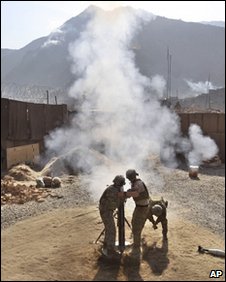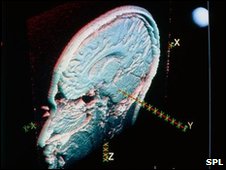
The disorder is prevalent among those exposed to life-threatening situations
A one-minute test appears to diagnose post-traumatic stress disorder with an accuracy of 90%.
The test measures the tiny magnetic fluctuations that occur as groups of neurons fire in synchrony, even when subjects are not thinking of anything.
These "synchronous neural interactions" have already been shown to distinguish signals from subjects with a range of disorders including Alzheimer's.
The latest work is reported in the
Journal of Neural Engineering.
The brain's signals are effectively a symphony of electrical impulses, which in turn drive tiny magnetic fields.
Researchers have measured and mapped these fields, in a pursuit known as magnetoencephalography, since the late 1960s. It has already been used to diagnose tinnitus, and can even predict when people will make mistakes.
Apostolos Georgopoulos, at the University of Minnesota in the US, developed the synchronous neural interactions (SNI) approach as a means to mathematically untangle the myriad signals that magnetoencephalography produces.
In 2007, he led a group that showed that SNI signals can distinguish between subjects with multiple sclerosis, Alzheimer's disease, schizophrenia, Sjögren's syndrome, and chronic alcoholism.
One to watchProfessor Georgopoulos and his colleagues have now used the approach to assess its accuracy in diagnosing post-traumatic stress disorder (PTSD).
The team recruited 74 military veterans who had already been diagnosed with PTSD alongside 250 members of the public.
The subjects were asked simply to stare at a dot for up to a minute while the magnetic signals were collected - a measure of the brain "at rest".
This is in contrast to preliminary results reported in 2009 that functional magnetic resonance imaging, or fMRI, may be useful in diagnosing post-traumatic stress disorder.
In that work, subjects were exposed to images of combat situations.
The SNI approach proved 90% accurate in discerning which subjects had PTSD.
"The excellent results obtained offer major promise for the usefulness of the SNI test for differential diagnosis," the team wrote, "as well as for monitoring disease progression and for evaluating the effects of psychological and/or drug treatment."
Dr Neil Greenberg, a researcher in military psychiatry at King's College London, expressed doubt that a clinical test of this sort solves the principal challenge in diagnosis.
"The main challenge with PTSD - with the military, emergency services, or journalists - isn't diagnosing it," he told BBC News.
"It's with getting people who might have the condition to come forward and have an assessment and treatment.

The approach teases out signals from neurons firing together
"If someone could go out and point a device at a hundred people and tell which of them would actually benefit from treatment but aren't going to come forward and get help, that would be useful."
He added that, in current practice, a treatment program would in any case be decided through the same lengthy behaviural questionnaires that are used to diagnose the disorder.
Rajendra Morey of Duke University, a researcher into the neurological basis of PTSD and other disorders, said that such reluctance to come forward is endemic across medicine, adding that the SNI approach "has a lot of merit" in the formal study of brain disorders.
"We already have behavioral measures to diagnose PTSD, but I think the strength here is that it can be done very rapidly and objectively," he told BBC News.
"The sort of stigma that PTSD is some kind of weakness may be overcome to some extent by establishing, by further confirming, that it's really changes in the brain and that we have objective measures of these changes.
"I think it's something that the scientific community, especially in PTSD and mental health research, will watch closely."
Reader Comments
to our Newsletter